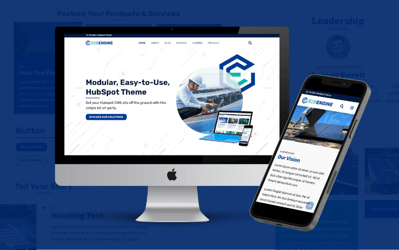Why B2B Marketing Fails: Overcoming Common Challenges

Most people think marketing is easy. In many cases, that’s what makes it so hard. Only 50% of companies survive more than 5 years in business. Only 30% of companies make it past year 10. And even then, most of these businesses could be doing better. Whether they realize it or not, their primary sources of headache are B2B marketing challenges.
Common B2B Marketing Challenges
From our experience, most of these problems fit into one of the following categories. Whatever industry you’re in, your business is likely facing at least one of these challenges. But we’re not here to write about problems. We’re here to offer solutions. Read on.
Marketing Challenge #1: Tactification
Marketers are under pressure. The marketing industry wants them to jump on every shiny new trend in this fast-moving field. The company leadership wants to see real results quickly. This leads to what marketing professor Mark Ritson calls tactification: a bias toward short-term, tactical marketing. It’s a house built on sand—it might seem to work for a while but, in the long run, it’s destined to fail. Just like so many businesses.
There may be many ways to market a product, but there’s only one way to build that marketing strategy. It takes three steps:
- Diagnose: run thorough research to understand consumer needs and the competitive landscape. The best insights come from combining quantitative and qualitative research while keeping track of the statistical and psychological validity of your findings.
- Strategize: build a comprehensive marketing strategy with clear objectives and key performance indicators. Goals should be SMART: Specific, Measurable, Achievable, Relevant, and Time-bound.
- Execute: create appropriate tactics and choose relevant channels to meet your strategic goals. Always keep in mind the insights you gained from the research phase.
Building a marketing strategy is a complex process, but once it’s completed, it should be easy to explain. It comes down to answering three simple questions: Who am I targeting? What is my position to that target? What are my strategic objectives for that target market?
Finding the answers won’t guarantee success, but it will set your marketing on the right path. But tactification is not the only thing that leads to failure. So does asking the wrong questions.
Marketing Challenge #2: Vanity Metrics
Tactification leads to another problem: if you’re doing the wrong thing, it doesn’t matter how well you’re doing it. With no strategic goals in place, and with pressure to demonstrate the results of their work, marketers often resort to meaningless metrics. These numbers might make you feel good about your business for a while, but they don’t really mean much without the right context. Here’s an example.
Let’s say you manage to decrease your cost per lead. This number is only meaningful in relation to cost per acquired customer and customer lifetime value. If you decrease one cost at the expense of the other, more important one, you will get into trouble. Setting the right goals will help you decide on the right metrics to measure to make sure you’re on the right track.
Marketing Challenge #3: Jobs to be Done
Don’t focus on what people buy. Focus on why they buy it.
Think of it this way: when someone buys your product, they hire it to do a job for them. If it does the job well, they’re likely to hire it again. “No one wants to buy a quarter-inch drill,” marketing professor Theodore Levitt observed, “They want a quarter-inch hole.” This concept is known as the Jobs to Be Done theory.
Most businesses are product-focused, trying hard to build a better or more affordable “drill.” Smart businesses, however, focus on the core customer’s needs and try to meet them in more efficient, affordable, and enjoyable ways. Sometimes it’s a better “drill,” sometimes it’s something else entirely.
You need to understand exactly what job your product is being hired to do. How? Keep asking questions—the five whys—until you get to the core desire that drives customers’ behavior. Then you will be able to meet it better than any of your competitors.
Mr. Levitt was right, but he gave up too soon: people don’t want a quarter-inch hole either, they need a shelf to showcase their library. Let’s see how it works:
The customer needs a quarter-inch drill.
Why?
Because they need a quarter-inch hole.
Why?
They want to build a shelf in their living room.
Why?
To showcase their library.
Why?
Due to the need for self-actualize by signaling knowledge.
Once you get an understanding of the real job your product is doing, you can make it do a better job. In this case, you can create a shelf that doesn’t require drilling or go even further and create Goodreads. The point is: you can’t meet your customer’s true needs well unless you know what they are.
Marketing Challenge #4: Customer Alignment
Knowing your customer’s true motivations should be a foundation of your customer alignment efforts. But what’s the point of having a foundation if you don’t build on it? Once you identify why people buy your product, it’s time to figure out how they use it. Not how they’re supposed to use it, or how you imagined they should use it, but how real people use your product in real life.
To get a complete picture of how your product fits into your customers’ lives, you will need to combine quantitative data (such as surveys, website analytics, conversion rates, etc.) and qualitative findings (in-depth interviews, focus groups, user studies). Your quantitative data should be statistically valid, but your qualitative findings need to be valid psychologically. Let me explain.
Simply asking your customers how they use your product won’t do. Why? Because most of the time, even they don’t know. Their motivations and behaviors are often subconscious, and their answers are biased by various psychological filters. The best insights come from observing, with their permission, how they use your product. This is fairly easy to do with the digital tools available to you. For example, tools like Hotjar let you observe in real-time people who use your website. But even with physical products, you can find ways to get precious data from people using your products in real life.
From this data, you will be able to gain insights that will help you design better experiences for your customers. Sometimes they will lead you to create new or improve existing products, but most of the time, you will simply need to provide better support to the customer. How? By delivering the right messages at the right time throughout their engagement with your product.
Time for a Change?
Are any of these problems keeping you up at night? B2B marketing challenges seem to be a bigger hurdle now than ever before, especially as the world continues to evolve and react to COVID-19. You may find that your old way of doing things is no longer working—and your old customer base has changed, too.
Is it time for a business pivot? Reach out to one of our marketing experts today.




